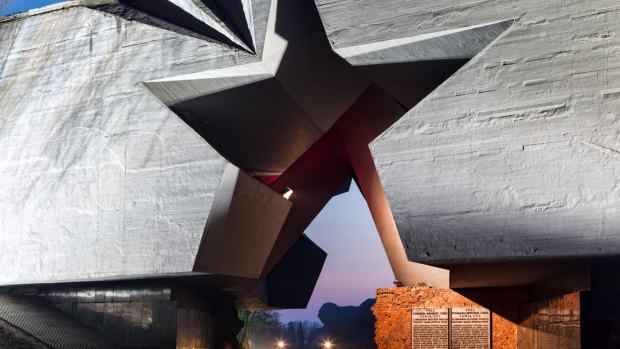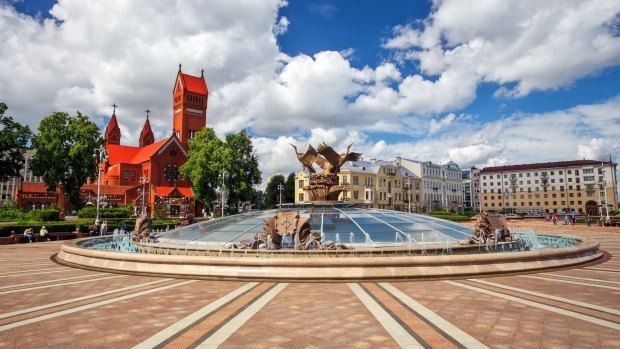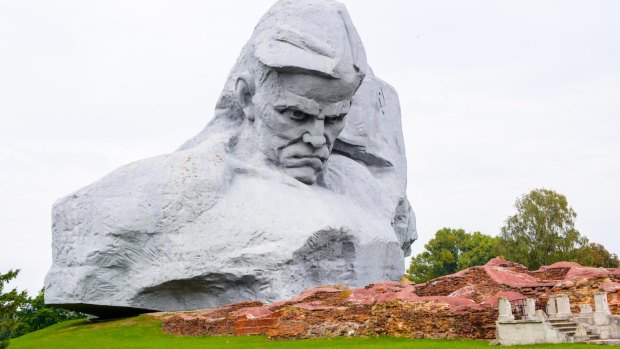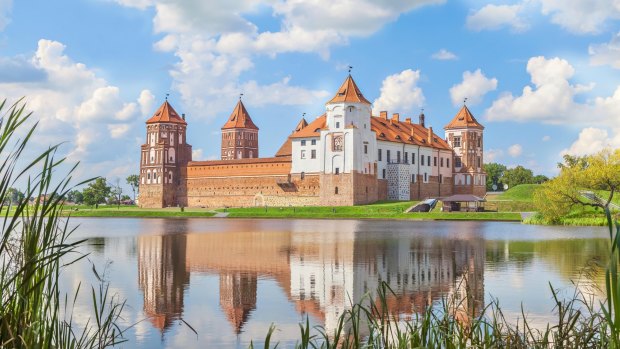This was published 5 years ago
Belarus travel guide: A five-day itinerary in 'Europe's last dictatorship'

The entrance to Brest fortress.Credit: Shutterstock
Let's be frank; Belarus has an image problem. Thanks in part to its nickname "Europe's last dictatorship" and to Hollywood scriptwriters who like reaching for a bearded Belarusian whenever they need a bad guy. Visas have also been a hurdle, but after the successful introduction of a five-day visa free entry, Belarus is now offering a 30-day visa free entry *. Given this new development Belarus makes a perfect European side-trip for curious travellers – just get there before the hordes catch on.
HOW TO SPEND FIVE DAYS.
DAY 1 MARVELLOUS MINSK

Independence Square in Minsk. Credit: Shutterstock
Nine-hundred-year-old Minsk was all but destroyed during Nazi occupation in World War II; its large Jewish population massacred and 85 per cent of its buildings and infrastructure destroyed. A post-war building frenzy saw the city remodelled in 50 shades of grey concrete, its dour design based on a typical Stalinist-era blueprint.
Yet, there's something about the ugly-beauty of Brutalist architecture that resonates with me. A strange nostalgia for something alien, yet familiar. I'm in my concrete element strolling the tank-wide promenades, past the Parliament Building with its Lenin statue, KGB headquarters (still going strong), and the commanding city gates, layered like a '50s wedding cake.
Independent since the dissolution of the Soviet Union in 1991, Belarus is a juxtaposition of Soviet time warp embraced with modernity. The streets are safe and clean, the people friendly, and hip bars and cafes abound. On one corner there's a Socialist monument perched on top of a Kentucky Fried Chicken store, on another a street art mural above a Lenin bust on Oktyabraskaya Street.

The unknown soldier monument of the Brest Fortress.Credit: Shutterstock
What was once a neighbourhood of factories and warehouses is now the street art strip of Minsk, a creative space filled with urban art, galleries and event spaces.
The afternoon takes me from the highs of the Gorky Park Ferris wheel to the lows of The Pit, a haunting monument to the Holocaust victims. I finish the evening spellbound by Tchaikovsky's Eugene Onegin at the Bolshoi Opera and Ballet Theatre. While most is lost in translation, the tale of fate, loss and longing echoes loudly in this city that has suffered so much.

Mir Castle is your quintessential Rapunzel-style fortress.
See also: The three-minute guide to Minsk
DAY 2 BEST OF BREST
A three-and-a-half-hour train trip from Minsk brings me to Brest on the Polish border, an intriguing border town that has been invaded, bombed and burned for much of its 1000-year history.
Our first stop is Brest Fortress, a 19th-century citadel at the confluence of the Bug and Mukhavets rivers. Today Brest Fortress remains a famous symbol of Soviet resistance during World War II, a sprawling tribute to the band of Red Army soldiers who held out for a month against the invading Nazis.
The grey skies are as foreboding as the bullet-ridden walls as we enter through the star-shaped gate. Inside the entire site has been turned into a memorial, a monolithic stone statue of a soldier's head projecting from a massive rock at its centrepiece. It's sobering to learn that 2.2 million Belarusians died during World War II – just over a quarter of the population.
Back in Brest city, the cobbled streets, onion-topped churches and trail of sculptural lamps depicting life in Brest in the 19th century are an uplifting antidote to the horrors of war.
To round off the afternoon I visit Brest Distillery "Belalco", its characteristic vodka bottles labelled with bison, Belarus' national animal.
See belarus.by
DAY 3 PARK LIFE
I meet more wildlife the next day in the Berezinsky Biosphere Reserve, a patchwork of coniferous forests, lakes and marshlands 120 kilometres north-east of Minsk. Home to Europe's Big Five – bison, moose, bear, wolf and lynx – it's where Belarusians come to commune with nature.
The reserve offers a wide program including bicycle tours, canoe trips, horse riding and bear watching.
With limited time I set off on the three-and-a-half-kilometre Mythological Trail. "Belarusians believe in three worlds," says guide Alexandra Karpova pointing to the trunk, roots and branches of a tree. "They represent the terrestrial, the underworld and the heavens."
Stepping through the dappled forest Alexandra points out birch, alder, aspen and oak trees, some with woodpecker marks, others with eyes that seem to follow us. Smaller plants add colour and texture. Blood-red strawberries carpet the floor, velvety mushrooms grow in shadows and carnivorous dew plants clutch at my ankles.
See berezinsky.by
DAY 4 INTO THE FOREST
The forests of Belarus, which cover 35 per cent of the country, are like no other. An Avatar-like wonderland, flush with conifers, saturated with swamps and embroidered with rivers and lakes, they represent some of the last tracts of primeval forest that once stretched across Europe.
To learn more about how Belarusians' lives are entwined with the forest I head west, to the infamous Naliboki Forest area. During World War II this is where a band Jewish partisans, led by the Bielski brothers, formed a successful resistance against the Nazis. The story of how they hid for two years, while rescuing more than 1200 Jews and fighting the German invaders has been told in the 2008 movie Resistance starring Daniel Craig.
"By nature Belarusians are forest people," says my guide Dzmitry Skvarcheuski. "After decades of hardship, it's where we feel the most safe."
The forest holds other secrets – glacial relics from the ice age, sacred stones, and "whisperers", a unique group of women who are said to have the power to heal the sick by whispering into water.
In the small village of Barok we meet Vasilii Frolov, a beekeeper who keeps his boxes hidden in the forest. "My family have been keeping bees here for 300 years," he says, leading me to his stash of bright blue boxes. "Our honey tastes of wild strawberry and apple blossoms."
Like other small farms in the district Frolov's is a relic of the state-owned collective farms. Today, Frolov, along with farmers in neighbouring villages are making fledgling steps into tourism, opening their doors as homestays, offering tours and showcasing their products. In Minsk boutique bars are incorporating forest herbs into bespoke cocktails.
DAY 5 CASTLES IN THE AIR
Belarus is home to dozens of castles and palaces, most constructed during the Grand Duchy of Lithuania times. The best preserved are two UNESCO-listed 16th century castles in the country's south-west, 100 kilometres from Minsk. Both are legacies of the Radziwills, a family of Lithuanian nobles with enough dramas to make Austria's Habsburgs look tame.
Mir Castle is your quintessential Rapunzel-style fortress, complete with five towers reflected perfectly in an adjacent pond. While the pond looks pretty enough it is rumoured to be cursed (unexplained drownings, white witches), which only adds to its mystique. Visitors can tour the grounds, towers, crypt and dungeon complex, or for a more complete experience, stay overnight.
The 30-roomed Nesvizh Castle is on a scale of its own, its opulent interiors harking back to the Tsarist-era palaces of Moscow. While a tour of the ballrooms and bedrooms of noble folk long past is interesting, it is the sprawling grounds that appeal the most. Threaded with walking trails and lakes you could easily spend the day sailing, hiking, biking, enjoying the sculptures, catching the toy train or watching artists at work. The two palaces are only 28 kilometres apart, so both can be visited as a day trip. See niasvizh.by mirzamak.by
FIVE UNUSUAL MUSEUMS
1. MUSEUM OF MYTHS
Deep in the Berezinsky Biosphere Reserve you'll find a tree-shaped museum dedicated to the guardians of the region. See berezinsky.by
2. CAT MUSEUM, MINSK
A sanctuary for homeless cats, this museum lets visitors play with cats, draw pictures of cats, play cat games and sample cat sweets. See catmuseum.by
3. MUSEUM OF MINIATURES, MINSK
A great introduction to Belarus' best-loved buildings, all hand-painted in miniature. See belarusmini.by
4. MUSEUM OF STONES, MINSK
An open-air geological gallery created to showcase the unique topography of Belarus. A short walk from Urucca metro station.
5. ALIVARIA BREWERY MUSEUM, MINSK
The oldest operating brewery in Belarus. See alivaria.by
TRIP NOTES
Kerry van der Jagt was a guest of the Belarusian Touristic Union (rsti.by) and the Embassy of Belarus in Australia (australia.mfa.gov.by)
MORE
TRAVEL
Etihad Airways flies from Sydney and Melbourne to Minsk via Abu Dhabi. See etihad.com
STAY
Hotel Monastyrski is a 48-room hotel housed in a former 17th century monastery. Rooms start from BYR 174 ($118). See monastyrski.by
TOUR
Based in Minsk, BelAgroTravel can organise day, overnight and multi-day tours to most popular sites. See trakt.by
VISAS
* Visa-free entry is available for residents of 74 countries – Australia included. You must enter and exit via Minsk National Airport and it's not available if you're flying to or from Russia. See australia.mfa.gov.by
See also: The new 'old Europe' is a land of blood and honey
See also: The most surprising countries Aussies can visit without visas
Sign up for the Traveller Deals newsletter
Get exclusive travel deals delivered straight to your inbox. Sign up now.